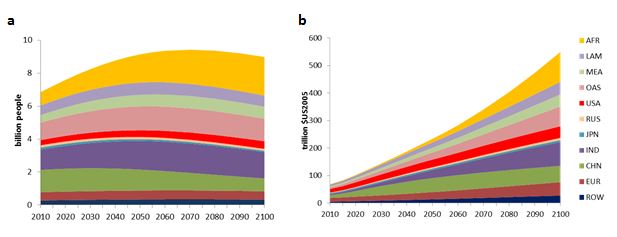Socio-economic drivers - REMIND-MAgPIE
| Corresponding documentation | |
|---|---|
| Previous versions | |
| Model information | |
| Model link | |
| Institution | Potsdam Institut für Klimafolgenforschung (PIK), Germany, https://www.pik-potsdam.de. |
| Solution concept | General equilibrium (closed economy)MAgPIE: partial equilibrium model of the agricultural sector; |
| Solution method | OptimizationMAgPIE: cost minimization; |
| Anticipation | |
Note: This pages describes the REMIND 1.7 model. It will be updated shortly to describe the most recent version of REMIND-MAgPIE.
Population and GDP are main drivers of future energy demand and, thus, GHG emissions in REMIND-MAgPIE. We base population and GDP inputs on the Shared Socio-economic Pathway (SSP) scenarios. REMIND-MAgPIE’s default population projections (both total population as well as working age population) are based on IIASA [1] (and the GDP scenarios from the OECD [2]. Both Population and GDP scenario data are available at https://secure.iiasa.ac.at/web-apps/ene/SspDb/dsd?Action=htmlpage&page=about. These projections are available for all five different SSP scenarios [3]. For default scenarios, we use SSP2 scenario data as they represent a middle-of-the road scenario. To calibrate GDP, which is an endogenous result of the growth engine in REMIND-MAgPIE, we calibrate labor productivity parameters in an iterative procedure so as to reproduce the OECD's GDP reference scenarios. Within REMIND-MAgPIE GDP is measured in market exchange rates (MER).
<figure id="fig:REMIND-MAgPIE_3">

Figure 1. Projections of (a) population and (b) GDP used in the REMIND-MAgPIE SSP2 (“Middle-of-the-Road”) scenario.
- ↑ KC S, Lutz W (2016) The human core of the shared socioeconomic pathways: Population scenarios by age, sex and level of education for all countries to 2100. Global Environmental Change in press. doi: 10.1016/j.gloenvcha.2014.06.004
- ↑ Dellink et al. (2015) Long-term growth projections in Shared Socioeconomic Pathways. Submitted to Global Environmental Change (submitted)
- ↑ O’Neill BC, Kriegler E, Riahi K, et al (2014) A new scenario framework for climate change research: the concept of shared socioeconomic pathways. Climatic Change 122:387–400. doi: 10.1007/s10584-013-0905-2